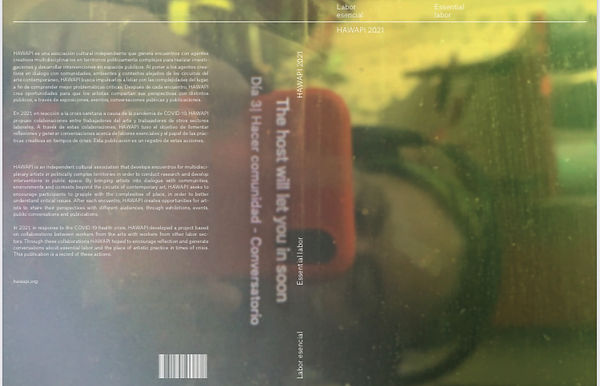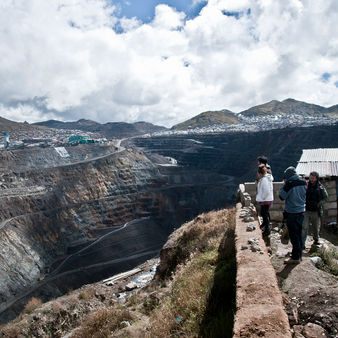
HAWAPI 2021 - Labor Esencial
En 2021, en reacción a la crisis sanitaria a causa de la pandemia de COVID-19, HAWAPI propuso colaboraciones entre trabajadores del arte y trabajadores de otros sectores laborales. A través de estas colaboraciones, HAWAPI tuvo el objetivo de fomentar reflexiones y generar conversaciones acerca de labores esenciales y el papel de las prácticas creativas en tiempos de crisis.
In 2021, in response to the COVID-19 health crisis, HAWAPI developed a project based on collaborations between workers from the arts with workers from other labor sectors. Through these collaborations HAWAPI hoped to encourage reflection and generate conversations about essential labor and the place of artistic practice in times of crisis.
El aire, el suelo y el agua
Rolly Calvo & Irazema H. Vera
El aire, el suelo y el agua es una composición sonora, materializada en un casete, que recoge paisajes sonoros y testimonios de las cotidianidades campesinas. Estas grabaciones se realizaron, por Rolly, en Uchiza, San Martín, y por Irazema, en Caritamaya, Puno. Estos diálogos y paisajes sonoros reflejan la faena en dos regiones y climas diferentes, pero comparten ciertos elementos y lidian con complejidades paralelas.
Como parte del proyecto, Rolly e Irazema organizaron sesiones de escucha abiertas en espacios públicos rurales, urbanos e digitales. Estos ejercicios de escucha profunda, al tratarse de paisajes naturales sonoros y faenas agrícolas, revelan pequeños vistazos de lo que significa practicar la agricultura en Perú en el contexto de un mundo globalizado y post-pandémico, desde los testimonios de un agricultor uchicino y una agricultora aymara.
El aire, el suelo y el agua (Air, soil and water) is a sound composition, materialized in cassette form, which collects soundscapes and testimonies of campesino daily life. These recordings were made by Rolly in Uchiza, San Martín, and by Irazema in Caritamaya, Puno. These dialogues and soundscapes reflect agricultural work in two different regions and climates, but share certain elements and deal with parallel complexities.
As part of the project, Rolly and Irazema organized open listening sessions in rural, urban and digital public spaces. These deep listening exercises, dealing with natural soundscapes and agricultural tasks, reveal small glimpses of what it means to practice agriculture in Peru in the context of a globalized and post-pandemic world, from the testimonies of a Uchicino farmer and an Aymara farmer.


Vivir en emergencia
Josefina Jiménez & Jhordan Ponce de León Goicochea
Vivir en Emergencia consistió en una serie de acciones en espacios públicos en Lima que buscaba visibilizar las condiciones de trabajo de algunas de las ollas comunes en Lima durante la emergencia sanitaria. El proyecto recopiló los testimonios de dos mujeres que han tomado la responsabilidad de dos ollas comunes para alimentar a su comunidad. Josefina y Jhordan luego crearon un guión con fragmentos sustraídos de estas conversaciones, con un enfoque sobre aquellas que resaltan las condiciones precarias en las cuales apoyaban a sus comunidades. Estas frases luego fueron proyectadas en las fachadas de distintos edificios en espacios públicos y pegadas como afiches en diversas calles de la ciudad.
Vivir en Emergencia visibilizó la precariedad alimentaria de muchos de los habitantes de Lima en un formato claro y directo, el cual entablando conversaciones sobre el poco respaldo que las iniciativas que luchan por hacerle frente a esta problemática reciben del estado.
Vivir en Emergencia (Living in Emergency) consisted of a series of actions in public spaces in Lima that sought to make visible the working conditions in which communal kitchens worked in the city during the health emergency. The project collected the testimonies of two women who have taken responsibility for two communal kitchens in order to feed their community. Josefina and Jhordan then created a script with excerpts taken from these conversations, with a focus on those that highlight the precarious conditions in which they supported their communities. These phrases were then projected on the facades of different buildings in public spaces and pasted as posters in various streets of the city.
Vivir en Emergencia made visible the food precariousness of many of the inhabitants of Lima in a clear and direct format, which began conversations about the lack of support from the state for initiatives that fight to face this problem.

Foto: Ernesto Benavides



Foto: Ernesto Benavides
Warmis
Miluska Silva & Renzo Rospigliosi
Warmis es un videocollage testimonial sobre una taxista y su relación con las danzas folclóricas como escape a la violencia de las calles de Lima.
Durante la pandemia Miluska creó un colectivo de taxistas mujeres para abordar los problemas de seguridad que enfrentan las mujeres, especialmente cuando viajan solas por la ciudad. Desde el relato y el video casero, Warmis teje el testimonial de Miluska como taxista en un sector de trabajo dominado por hombres. Las imágenes extraídas de la vida digital de Miluska, como sus vídeos en TikTok, y su practica de la Morenada son presentadas como tácticas de escape a los regímenes hetero-normativos que dictan que lo femenino sea percibido como débil.
Warmis is an audiovisual collage that is a portrait of a taxi driver and her relationship with folk dances as an escape from the violence on the streets of Lima.
During the pandemic Miluska created a collective of female taxi drivers to address the security issues faced by women, especially when traveling alone through the city. Through her personal story and home videos, Warmis weaves a portrait of Miluska as a taxi driver in a male dominated world. The images extracted from Miluska's digital life, such as her TikTok videos, and her practice of the Morenada traditional dance, are presented as escape tactics from the hetero-normative regimes that dictate that the feminine is perceived as weak.

Foto: Renzo Rebagliati

Rito Oval ceramic planter pots fastened to a metal structure within a larger structure made with wooden antique window frames. 89 x 70 x 66 cm. 2021 Foto: Renzo Rebagliati

Rito, Ruruchay Casa de Nacimientos en el Valle Sagrado, Cusco, septiembre de 2021. Foto: Jeremy Pilain

Foto: Renzo Rebagliati
Rito
Ruro Caituiro Monge & María Inés Agurto
Rito es un espacio escultórico y un ritual de sanación generado con la participación de mujeres que han tenido algún tipo de pérdida en el proceso de ser madres. Durante el ritual cada mujer siembra una semilla en una maceta en honor al ser con el que continúan compartiendo una conexión trascendental, pero que ya no está en el plano terrenal. Estas macetas son colocadas en una estructura metálica en forma de un espiral, el cual está dentro de una estructura hecha con marcos de ventana. Las ventanas, unidas en forma de claraboya, surgen en base al nombre en latín “fontanella” que significa “ventana pequeña”. En el nacimiento, la fontanela craneal de la madre se abre al mismo tiempo que se abre la fontanela del bebé, por donde atraviesa un rayo de luz creando una unión desde el sol hacia la tierra, tal y como ocurre desde la madre hacia el bebé, completando un ciclo de vida.
El primer ritual tuvo lugar en Ruruchay Casa de Nacimientos en el Valle Sagrado, Cusco en septiembre de 2021.
Rito is a sculptural space and a healing ritual created with the participation of women who have suffered some kind of maternity-related loss. During the ritual each woman plants a seed in a small plant pot in honor of the being with whom they continue to share a transcendental connection, but who is no longer on the earthly plane. These pots are placed in a metal structure in the shape of a spiral, which is fixed inside another structure made from window frames. The windows, joined in the shape of a sky-light, respond to the Latin word “fontanella” which means “small window”. During a birth, the mother's cranial fontanel opens at the same time that the baby's fontanel opens. A ray of light passes through these openings, creating a union from the sun to the earth, as occurs from mother to baby, completing a life cycle.
The first ritual took place at Ruruchay Casa de Nacimientos in the Sacred Valley, Cusco in September 2021.
Otros encuentros posibles
Cristina Benito, Yojhami Trujillo & Isabel Guerrero
Otros encuentros posibles consistió de dos talleres y la producción de un podcast testimonial. Los talleres, elaborados en conjunto con la Institución educativa Sembrando Juntos de Pachacutec Ventanilla (Callao), tuvieron el objetivo de abrir un espacio de escucha a la comunidad, para recoger testimonios, pensares y sentires de maestras, madres y padres de familia, frente al retorno seguro a clases en contexto de pandemia.
El proyecto tuvo dos etapas: la primera fue un taller virtual y la segunda un taller presencial ambulante en la zona de la escuela. En ambos se abordaban temas como los espacios de aprendizaje, conceptos de la educación ideal y el retorno seguro de clases, para generar y construir en conjunto la posibilidad de espacios seguros. Los talleres emplearon el testimonio como detonante y activador de otros sentires, a partir de los cuales se construyó un "podcast testimonial" que se puede aplicar a otros contextos educativos.
Otros encuentros posibles (Other possible meetings) consisted of two workshops and the production of a podcast. The objective of the workshops, developed in conjunction with the educational institution Sembrando Juntos of Pachacutec Ventanilla (Callao), was to open up a space for listening to the community, and to collect testimonies, thoughts and feelings, from both parents and teachers, regarding the safe return to classes in the context of the pandemic.
The project consisted of two distinct stages: the first was a virtual workshop, and the second was an in-person walking workshop in the area where the school is situated. On both occasions, the groups addressed themes related to learning spaces, concepts of an ideal education, and the safe return to classes, in order to generate and jointly build the possibility of safe spaces. The workshops focused on using testimony as a trigger and activator of other knowledges. From this process a “testimonial podcast” was created, which in the future can be applied to other educational contexts.
Saberes Agrícolas
Bitia Chávez & Colectivo Illapa
Saberes Agrícolas es una serie de libros de artista de edición única. Cada uno de los libros está dedicado a una semilla agrícola andina. En el marco de HAWAPI 2021, Bitia y el Colectivo Illapa desarrollaron los primeros dos libros de la serie, “Wara” (Quinoa) y “Uqa” (Oca).
El proceso de elaboración de los libros ha contado con información y testimonios proporcionados por cinco mujeres de diferentes edades ligadas a labores agrícolas y poseedoras de saberes invaluables en torno a la agricultura. De este modo el proyecto es un intento por preservar, valorar y diseminar los saberes ancestrales agrícolas.
Adaptaciones impresas de los libros Wara y Uqa fueron presentados en una entrega gratuita junto con semillas de ambas especies en diversos espacios públicos de Cusco. Luego de la entrega se convocó una reunión con el Círculo de Estudios en Calidad Ambiental en el bosque colindante al Complejo Arqueológico de Q’enqo para conversar acerca de la agricultura urbana con públicos diversos.
Saberes Agrícolas (Agricultural Knowledge) is a series of single-edition artist books. Each of the books is dedicated to an Andean agricultural seed. Within the framework of HAWAPI 2021, Bitia and the Illapa Collective developed the first two books in the series, “Wara” (Quinoa) and “Uqa” (Oca).
The process of preparing the books included gathering information and testimonies from five women of different ages linked to agricultural labor who possess invaluable knowledge about agriculture. In this way, the project is an attempt to preserve, value and disseminate ancestral agricultural knowledge. Printed adaptations of the “Wara” and “Uqa” books, along with seeds of both species, were handed out for free in various public spaces in Cusco. Afterwards, a meeting to discuss urban agriculture with diverse audiences was convened along with the Study Circle for Environmental Quality, in the forest adjacent to the Q'enqo Archaeological Complex.

Foto: Alfredo Velarde

Foto: Alfredo Velarde

Foto: Alfredo Velarde

Foto: Alfredo Velarde












